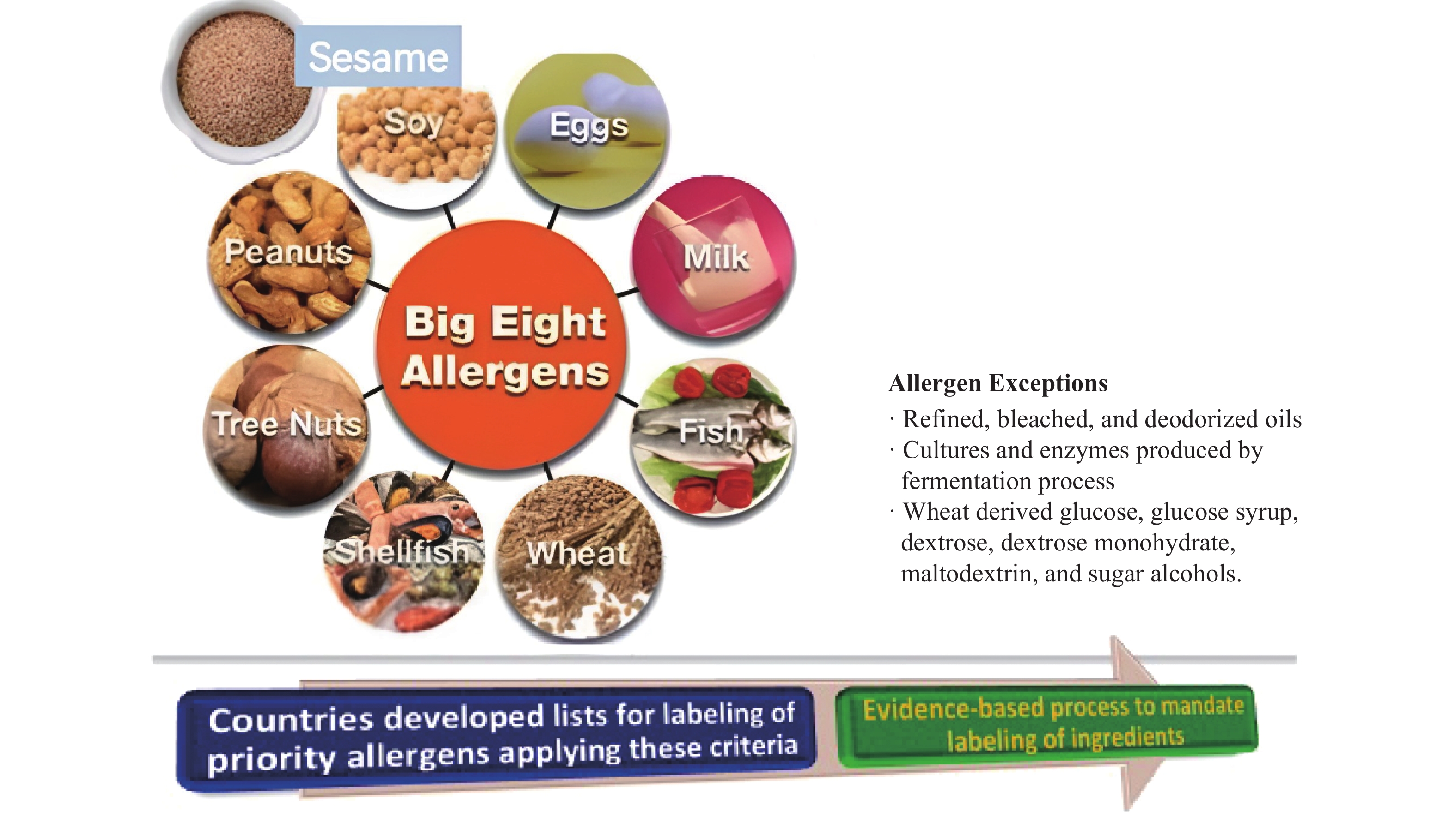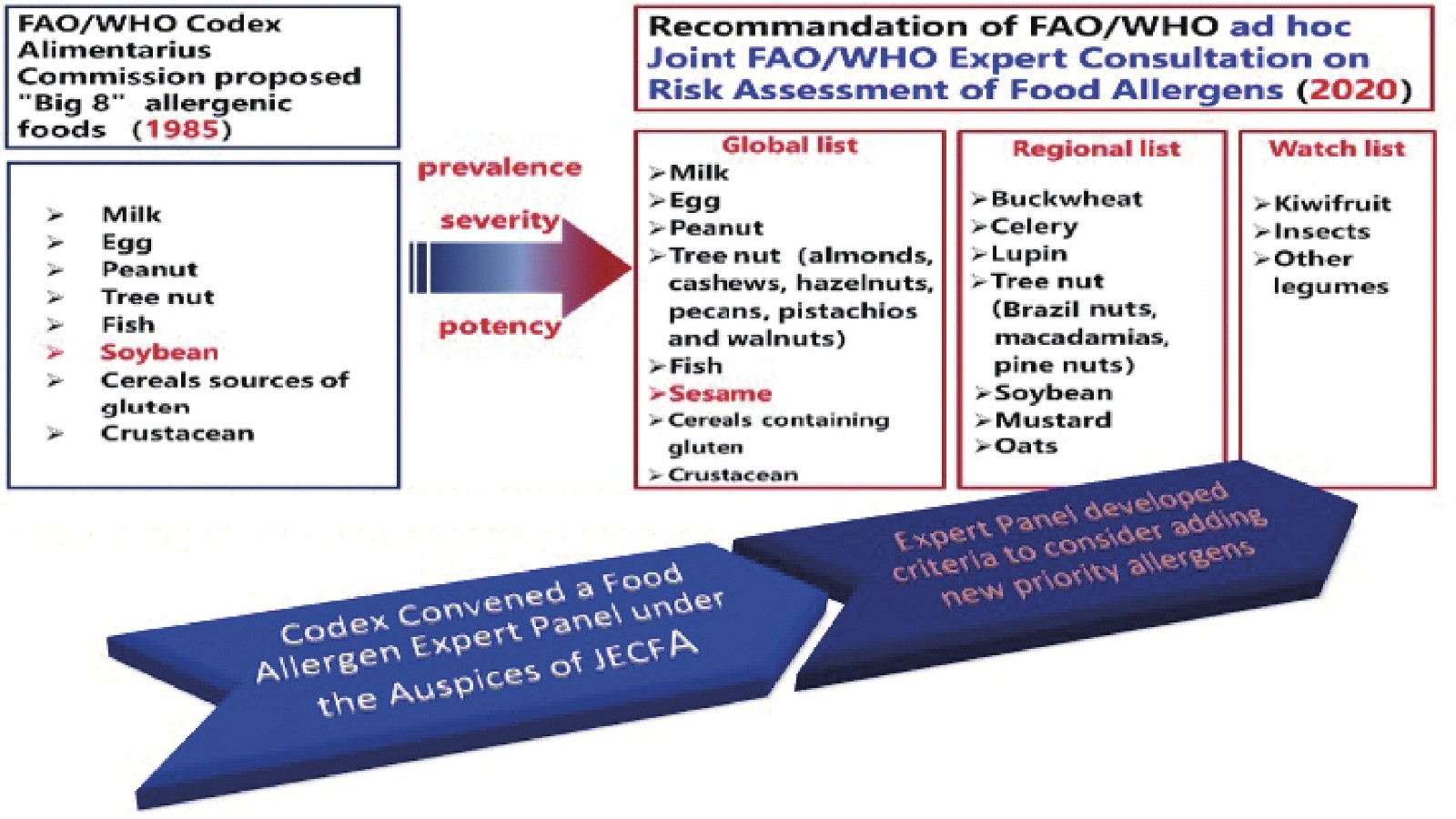-
Held on the 8th of July every year, World Allergy Day is a global joint initiative launched by the World Health Organization (WHO) and the World Allergy Organization (WAO) as well as other national allergy agencies, which aims to raise the general public awareness of the importance of managing and preventing allergic diseases. Food allergies are a major source of exposure to allergens and a significant public health problem globally with increasing prevalence (1). Importantly, there is currently no effective cure for food allergies and the only strategy for preventing food allergic reactions is to practice a strict avoidance diet. Notably, implementation and adherence to a diet that is free of allergenic foods is challenging because a consumer may be allergic to more than one food or food ingredient and must face a wide variety of food choices in daily life. Therefore, the labeling of allergenic foods and food ingredients on pre-packaged foods can play a critical role in protecting food-allergic individuals. Based on the recommendations of an expert consultation convened by WHO and the Food and Agriculture Organization of the United Nations (FAO), the labeling of the eight most common allergenic foods (commonly known as the “Big Eight”) was incorporated into the Codex General Standard for the Labeling of Packaged Foods (GSLPF) in 1999 (2). Subsequently, member countries of the Codex Alimentarius Commission developed their own national lists for labeling of allergens in pre-packaged food based on the Codex list and on evidence of allergenicity of other foods and food ingredients (Figure 1).
 Figure 1.
Figure 1.The eight most common food allergens (i.e., “Big Eight” or “Big 8”) in the Codex with evidence-based process to mandate labeling of ingredients.
Since the original drafting of the GSLPF, scientific understanding of food allergens and their management have evolved. In response, Codex requested the WHO/FAO to provide updated advice, and a series of meetings of the Joint FAO/WHO Expert Consultation on Risk Assessment of Food Allergens were held during 2020 and 2022 (2).
The establishment of priority allergenic foods recommended by the Expert Consultation was based on three criteria: 1) prevalence (e.g., the proportion of a defined population known to have experienced an immune-mediated adverse reaction to the specific food); 2) potency (e.g., the amount of the total proteins from the food/ingredient required to cause objective symptoms in a specified proportion of the population allergic to that specific food); and 3) severity (e.g., frequency or proportion of severe objective reactions to a food/ingredient, such as anaphylaxis). After a systematic and thorough assessment based on these three criteria, the Expert Consultation recommended the following allergenic foods should be listed as priority allergens in the GSLPF:
• cereals containing gluten
• crustacean shellfish
• eggs
• fish
• milk
• peanuts
• sesame
• specific tree nuts (hazelnut, walnut, pecan, cashew, pistachio, and almond).
It is worth noting that soybeans have been excluded from the list of global priority allergens, which has been replaced by sesame as a new member among the “Big Eight”. In addition, some potential allergens, such as buckwheat, mustard, soybean, lupin, Brazil nut, oat, molluscan shellfish, and others may still be considered for inclusion in priority allergen lists in individual countries or regions (Figure 2).
 Figure 2.
Figure 2.The list of global priority allergens by ad hoc Joint FAO/WHO expert consultation on risk assessment of food allergens: sesame has replaced soybeans as a new member among “Big Eight”.
Abbreviation: FAO=Food and Agricultural Organization of the United Nations; WHO=World Health Organization; WAO=World Allergy Organization; JECFA=FAO/WHO Joint Expert Committee on Food Additives. -
China has gradually established a research framework for risk assessment of food allergens. Research efforts have included work on the three key criteria of food allergy needed to implement a risk assessment framework — namely, prevalence, potency, and severity. Regarding food allergy epidemiology, more than 60 articles on the prevalence of food allergy in China have been published since 1996. These epidemiological studies were geographically distributed, including Beijing, Shanghai, Hangzhou, Guangzhou, Shenzhen, Wenzhou, Chongqing, and other cities. Interestingly, research on the prevalence of celiac autoimmunity disease (0.36%; 95% Cl: 0.28%–0.46%) was first reported in the general Chinese youth population (3). This was followed by a report on the prevalence of celiac disease (0.35%; 95% Cl: 0.11%–0.59%) in Xinjiang Uyghur Autonomous Region (4). To evaluate the allergenic potency of specific allergenic foods among the Chinese population, oral food challenge testing (OFC) is essential. Thankfully, ten tertiary grade A hospitals have established a base for conducting OFC in China. Peking Union Medical College Hospital was the first to release a ranking of the causes of food-related anaphylaxis among Chinese people and validated that there were significant regional differences in the causes of anaphylaxis (5). This clinical research will also help to fill a void of information on the severity of food allergy in China (5). Furthermore, the Chinese government has financed special projects, including the National Key Basic Research Program (“973” Program), the National High Technology Research and Development Program (“863” Program) and the National Science and Technology Supporting Program to support scientific research on the risk assessment of food allergens, leading to the formulation of more than 20 national standards. Meanwhile, many national and international conferences on food allergy were held in China during the past 5 years, which strengthened multidisciplinary collaboration, innovation and academic exchange in food science, basic immunology, clinical medicine, public health nutrition and sociology.
Although China has carried out some relevant research on risk assessment of allergenic foods, certain limitations still remain. Most studies on the prevalence of food allergy were restricted to specific regions, and high-quality data on prevalence were limited, in part, due to the lack of a uniform diagnostic protocol based on OFC using well-defined food challenge materials. The determination of the threshold doses for specific allergenic foods among Chinese food-allergic individuals has not been conducted and presents clinical challenges in China. Furthermore, allergen risk assessment also requires detailed information on eating patterns of Chinese consumers and sub-groups of those consumers. There are no specific dietary surveys based on consumers with food allergy in China even though total diet databases were established for dietary exposure assessment purposes. Under the circumstances, a list of priority allergenic foods based upon the actual situation of the Chinese population is not currently available. Accordingly, the relevant provisions on allergenic food labeling in China’s General Rules for the Labeling of Pre-Packaged Foods (GB 7718) were basically the same as the corresponding Codex provisions.
-
Risk assessment techniques provide a scientific basis for governments to make scientifically sound regulatory decisions, for companies to set appropriate safety standards, and for populations to make safe consumption choices. Regarding risk assessment of food allergens, regulators need to consider the current quality assurance practices of food companies and balance those practices against the desired level of protection of allergic populations. Companies are concerned with the products they produce in light of “farm-to-table” safety assurance and the need to prevent/minimize cross and carry-over contamination of allergens during the transportation of raw materials, product processing, and packaging and to assess the risk of their products according to safety limits. Ultimately, food allergy risk assessment is about safeguarding food safety for consumers.
The future scientific development of food allergen risk assessment in China must address several different aspects of the current situation. The first step is to carry out a nationwide epidemiological survey on the prevalence and incidence of food allergy to understand the existing level of risk faced by food-allergic Chinese consumers. This survey should lead to knowledge of the most common allergenic foods in China and a realistic gauge of the severity of food allergic reactions that happen within China. The survey should focus on the risk factors for food-allergic reactions within the Chinese population and determine which of those factors can be better controlled with improved and targeted interventions.
Moreover, based on the best practice for food allergy diagnosis, a double-blind placebo-controlled food challenge trial in multi-center hospitals should be conducted to establish individual and population thresholds, and further quantitative risk assessment should be carried out based on the thresholds of the major allergens. The monitoring of individual clinical symptoms should be strengthened and the severity of allergic reactions at various doses used in the clinical challenges could be recorded. That clinical data can then be compared to the symptoms reported by food-allergic consumers to better assess the nature of the symptoms occurring within the community versus the doses administered in the clinical challenges. Based on the epidemiology of food allergies, allergen thresholds and severity of allergic reactions in the Chinese population, the decisions on what and how to label food allergens in China will be effectively addressed based on sound clinical and scientific information, providing benefits to relevant stakeholders.
HTML
| Citation: |





 Download:
Download:




